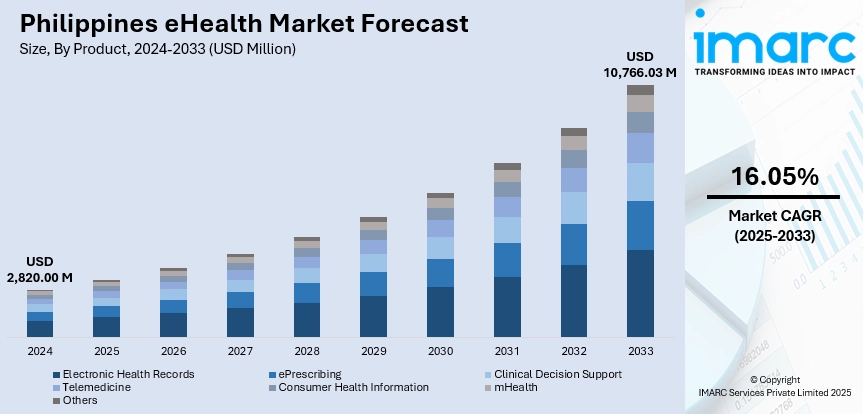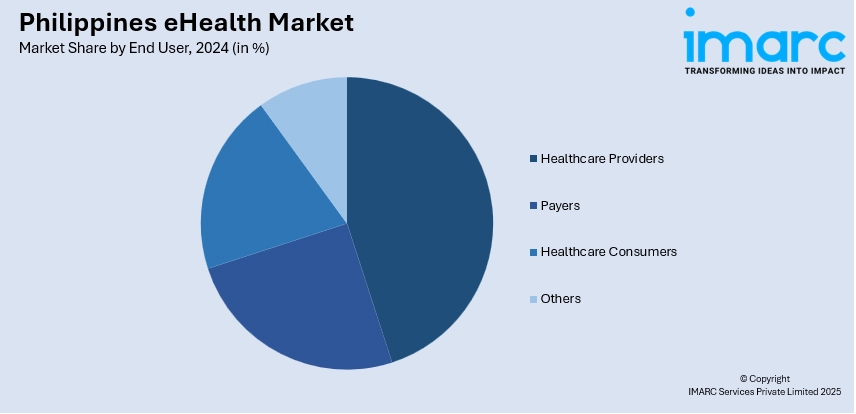
Philippines eHealth Market Size, Share, Trends and Forecast by Product, Services, End User, and Region, 2025-2033
Philippines eHealth Market Overview:
The Philippines eHealth market size reached USD 2,820.00 Million in 2024. The market is projected to reach USD 10,766.03 Million by 2033, exhibiting a growth rate (CAGR) of 16.05% during 2025-2033. The growing incidence of chronic diseases is offering a favorable market outlook. eHealth solutions empower patients with greater awareness and self-management of their health, fostering a more proactive approach to treatment. Besides this, increasing focus on advanced medical education is contributing to the expansion of the Philippines eHealth market share.
|
Report Attribute
|
Key Statistics
|
|---|---|
|
Base Year
|
2024
|
|
Forecast Years
|
2025-2033
|
|
Historical Years
|
2019-2024
|
| Market Size in 2024 | USD 2,820.00 Million |
| Market Forecast in 2033 | USD 10,766.03 Million |
| Market Growth Rate 2025-2033 | 16.05% |
Philippines eHealth Market Trends:
Growing prevalence of chronic ailments
Rising incidence of chronic illnesses is positively influencing the market in the Philippines, as the country is witnessing a surge in conditions, such as diabetes, cardiovascular diseases, hypertension, and respiratory disorders, which require continuous monitoring and long-term management. The Philippine Statistics Authority indicated that the leading causes of death in the Philippines from January to December in 2024 were ischemic heart diseases, neoplasms, and cerebrovascular diseases. Conventional healthcare systems frequently encounter difficulties in managing the increasing number of patients, resulting in inefficiencies, postponed treatments, and elevated expenses. eHealth solutions, such as telemedicine services, remote monitoring tools, mobile health applications, and electronic health records (EHRs), offer a practical method to close these gaps by allowing patients to oversee their health conditions more effectively from home while remaining linked to healthcare professionals. This method decreases the number of hospital visits while also guaranteeing quick interventions and improved health results. Remote glucose monitoring and wearable heart devices enable doctors to monitor patient health instantly and implement faster modifications to treatment strategies. Moreover, digital platforms enable patients to gain increased awareness and control over their health, promoting a more active stance towards treatment. With chronic illnesses exerting greater pressure on the healthcare system and family finances, the integration of eHealth technologies is becoming crucial.

To get more information on this market, Request Sample
Increasing focus on advanced medical education
Rising focus on advanced medical education is propelling the Philippines eHealth market growth by creating a skilled workforce capable of effectively integrating digital health technologies into mainstream healthcare. With the increasing importance of digital tools, such as telemedicine platforms, EHRs, mobile health apps, and AI-based diagnostics, medical professionals require specialized training to utilize these systems efficiently. Universities in the Philippines are launching dedicated courses on eHealth and health informatics, equipping future doctors, nurses, and healthcare workers with digital competencies that align with evolving healthcare needs. In July 2025, the University of the Philippines (UP) Manila was set to provide a certificate course in medical imaging and health informatics for radiographers and medical officers. Implemented in partnership with the FUJIFILM Asia Pacific Healthcare Learning Academy (UP-FAHLA), the initiative sought to provide state-of-the-art education, research, and industry partnerships to enable healthcare practitioners to foster advancements that could enhance patient outcomes. Healthcare informatics foundation would familiarize students with health information systems (HIS) and EHR deployment. This emphasis on advanced medical education ensures that practitioners are better prepared to provide patient-centered care in both traditional and virtual settings, thereby enhancing the adoption and credibility of eHealth solutions.
Philippines eHealth Market Segmentation:
IMARC Group provides an analysis of the key trends in each segment of the market, along with forecasts at the country and regional levels for 2025-2033. Our report has categorized the market based on product, services, and end user.
Product Insights:
- Electronic Health Records
- ePrescribing
- Clinical Decision Support
- Telemedicine
- Consumer Health Information
- mHealth
- Others
The report has provided a detailed breakup and analysis of the market based on the product. This includes electronic health records, ePrescribing, clinical decision support, telemedicine, consumer health information, mHealth, and others.
Services Insights:
- Monitoring
- Diagnostic
- Healthcare Strengthening
- Others
A detailed breakup and analysis of the market based on the services have also been provided in the report. This includes monitoring, diagnostic, healthcare strengthening, and others.
End User Insights:

- Healthcare Providers
- Payers
- Healthcare Consumers
- Others
A detailed breakup and analysis of the market based on the end user have also been provided in the report. This includes healthcare providers, payers, healthcare consumers, and others.
Regional Insights:
- Luzon
- Visayas
- Mindanao
The report has also provided a comprehensive analysis of all the major regional markets, which include Luzon, Visayas, and Mindanao.
Competitive Landscape:
The market research report has also provided a comprehensive analysis of the competitive landscape. Competitive analysis such as market structure, key player positioning, top winning strategies, competitive dashboard, and company evaluation quadrant has been covered in the report. Also, detailed profiles of all major companies have been provided.
Philippines eHealth Market News:
- In June 2025, telehealth startup &you, based in Manila, obtained pre-seed funding from international investors. The investment would facilitate scaling engineering, growing local operations, and gearing up for expansion into new sectors in the Philippines by June 2026. The firm was set to launch a comprehensive localized system, encompassing mobile onboarding, medical intake, prescription, and nationwide delivery. The platform would utilize cutting-edge technology to assist users in evaluating their health and link them with certified local physicians to develop tailored treatment strategies.
- In March 2024, the Philippine Digital Health Summit took place at the Makati Diamond Residences, Philippines, focusing on digital health initiatives aimed at enhancing healthcare delivery in the nation as part of the new Philippine Digital Health Strategy 2024-2028. The summit aimed to convey the strategic-operational guidelines regarding Philippine digital health for Universal Health Care (UHC) and to foster a cooperative atmosphere for stakeholders to strategize, plan, and synchronize their initiatives, development, and support for the Philippine digital health strategy.
Philippines eHealth Market Report Coverage:
| Report Features | Details |
|---|---|
| Base Year of the Analysis | 2024 |
| Historical Period | 2019-2024 |
| Forecast Period | 2025-2033 |
| Units | Million USD |
| Scope of the Report |
Exploration of Historical Trends and Market Outlook, Industry Catalysts and Challenges, Segment-Wise Historical and Future Market Assessment:
|
| Products Covered | Electronic Health Records, ePrescribing, Clinical Decision Support, Telemedicine, Consumer Health Information, mHealth, Others |
| Services Covered | Monitoring, Diagnostic, Healthcare Strengthening, Others |
| End Users Covered | Healthcare Providers, Payers, Healthcare Consumers, Others |
| Regions Covered | Luzon, Visayas, Mindanao |
| Customization Scope | 10% Free Customization |
| Post-Sale Analyst Support | 10-12 Weeks |
| Delivery Format | PDF and Excel through Email (We can also provide the editable version of the report in PPT/Word format on special request) |
Key Questions Answered in This Report:
- How has the Philippines eHealth market performed so far and how will it perform in the coming years?
- What is the breakup of the Philippines eHealth market on the basis of product?
- What is the breakup of the Philippines eHealth market on the basis of services?
- What is the breakup of the Philippines eHealth market on the basis of end user?
- What is the breakup of the Philippines eHealth market on the basis of region?
- What are the various stages in the value chain of the Philippines eHealth market?
- What are the key driving factors and challenges in the Philippines eHealth market?
- What is the structure of the Philippines eHealth market and who are the key players?
- What is the degree of competition in the Philippines eHealth market?
Key Benefits for Stakeholders:
- IMARC’s industry report offers a comprehensive quantitative analysis of various market segments, historical and current market trends, market forecasts, and dynamics of the Philippines eHealth market from 2019-2033.
- The research report provides the latest information on the market drivers, challenges, and opportunities in the Philippines eHealth market.
- Porter's five forces analysis assist stakeholders in assessing the impact of new entrants, competitive rivalry, supplier power, buyer power, and the threat of substitution. It helps stakeholders to analyze the level of competition within the Philippines eHealth industry and its attractiveness.
- Competitive landscape allows stakeholders to understand their competitive environment and provides an insight into the current positions of key players in the market.
Need more help?
- Speak to our experienced analysts for insights on the current market scenarios.
- Include additional segments and countries to customize the report as per your requirement.
- Gain an unparalleled competitive advantage in your domain by understanding how to utilize the report and positively impacting your operations and revenue.
- For further assistance, please connect with our analysts.
 Request Customization
Request Customization
 Speak to an Analyst
Speak to an Analyst
 Request Brochure
Request Brochure
 Inquire Before Buying
Inquire Before Buying




.webp)




.webp)












